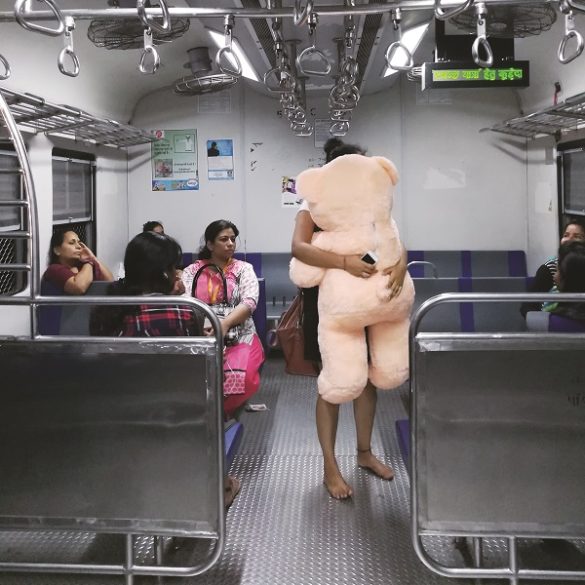Prachi Sahasrabudhe
Part 3- The Liminality of private spaces: Taking a Look into women-only spaces
The photographs by Anushree Fadnavis, Nishat Fatima and Bharat Chaudhary represent various dimensions of women in private spaces and challenge the traditional portrayal of women in public spaces and offer a glimpse into their personal lives. They also shed light on the complex relationship between gender, space, and identity.
Anushree Fadnavis – Women in Mumbai Trains
Anushree Fadnavis is a well-known Reuters photographer on Instagram who has around 100,000 followers. She became renowned for her five-year-long series of photos of women travelling in the ladies’ compartment on the iconic Mumbai local trains, which she posts online with the hashtag “#traindiaries.” She began this as a virtual diary to record the people and stories around her. The significance of Mumbai’s local trains is redefined in Anushree Fadnavis’s series of Instagram photographs.
Fadnavis’s subjects are working-class women in the city who rely upon local trains to get to work, and she pictures them with the comfort of a fellow commuter. In Fadnavis’s photographs, close-ups are unusual, and the interiors of the coaches typically serve as a backdrop, presumably as a constant reminder of the significance of these trains in their lives. The women are mostly lost in their thoughts, and Fadnavis’ framing of the pictures gives them a significance that makes them stand out. She has a fondness for transgender ladies, many of whom pose for her with a welcoming smile.
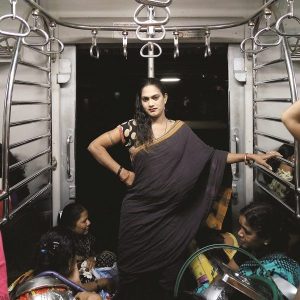
In above image, transgender woman Anita poses for a photo in the ladies’ section of a Mumbai local train. Anita’s was one of the first few photos clicked by Fadnavis that served as the foundation for her transsexual project.
Fadnavis enjoys capturing basic, no-fuss images in natural light using her phone. What completes the picture, though, are the lengthy comments she writes with each shot, which convey her feelings as well as the experiences of her subjects. She is never a neutral observer and appears to try to befriend the ladies she captures in her photographs. She thinks people exchange lifelong experiences with one another and that it only takes one journey or one conversation to acquire perspective on life.
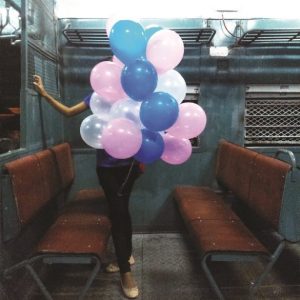
Fadnavis claims that the photograph of a girl holding balloons is one of her favourites. The girl carried balloons for her cousin’s birthday. In this photograph, Aditi is clutching helium balloons on the Mumbai local train’s ladies’ compartment, as she waits for her stop to arrive. She purchased the balloons as a special birthday present for her cousin, and she was her route to her cousin’s home when she bought them. When Aditi told Fadnavis what she intended to do with the balloons, Fadnavis thought Aditi’s action was sweet and thanked her for sharing the thought with her.
Fadanvis reveals stories behind the pictures she took, which inspired her to capture the moment in time. Following are to mention a few:
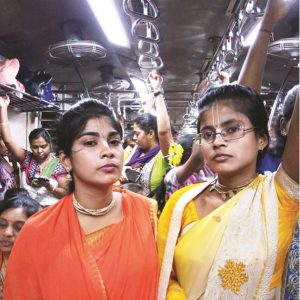
Pooja and Radhika, who are both Iskcon members, pose for a photo in the women’ compartment of a Mumbai local train while wearing prayer beads and wearing the “Diksha” vow. After receiving Diksha, Radhika was given the name Parmanandi Rasmayi Gopi, while Pooja was given the name Parmanandi Madhavi. Diksha/Deeksha is frequently conferred in a one-on-one ceremony, and it frequently entails adopting a rigorous spiritual practise. In some Indian traditions, it is also known as the guru imparting a mantra or initiating someone. They caught Fadnavis’s eye despite how crowded the train was.
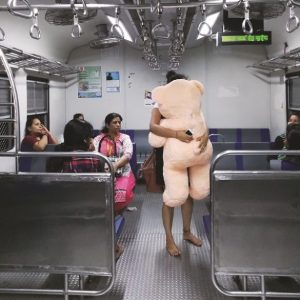
In this photo, a girl is seen carrying a Teddy bear that her friends gifted her for her 17th birthday. When asked why she was barefoot while carrying the enormous bear, she told Fadnavis that she was wearing heels but took them off out of fear of falling. In the photograph’s description, Fadavis adds, “Sometimes you meet some strangers, have a big long chat but forget to ask their name. I do not know why somehow that happened with me today. But I think her name was Manisha when a friend of her called out to her from a platform. But I did give her birthday wishes.”
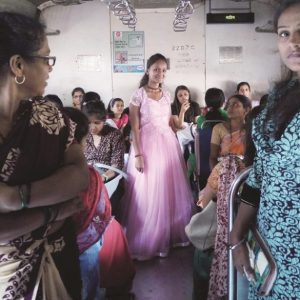
Runali (20) poses for a picture in the ladies’ compartment of the local train in Mumbai. She is floating on the platform when Fadnavis observes her wearing a lovely pink outfit. Fadnavis notices her and remembers how fascinating it was for her to wear a similar flowing outfit as a child. Fadnavis asserts, “The memories of my childhood flashed before me. Rapunzel, Cinderella, Thumbelina. I knew it must be a special day. It was her birthday. I followed her. When she got in the train, she was lost in the crowd with her gown. I asked her if she could pose for a picture and told her she looks lovely in that dress. And she did. I do not know how someone can travel in a crowded train with such a beautiful dress. She was on her way to celebrate her birthday with her friends. I got off with her and wished her happy birthday.”
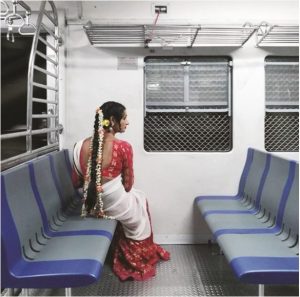
Kinjal, a transgender, poses for a photograph in the ladies’ compartment of a Mumbai local train. Fadnavis knew Kinjal from a social event she had attended with her trans friends. Fadnavis mentions, “We had a lovely conversation in which I told her that I loved her Gajra (flower garland) and her half saree (the south Indians wear this as their traditional wear).”
Nishat Fatima- behind the veil – Muslim women in weddings:
Nishat was fascinated to fashion as a youngster and devoured fashion publications, but she discovered photography through art. When she was 17 or 18, she came across Imogen Cunningham, a photographer famed for her nude self-portraits and botanical photography. She has been taking pictures ever since she studied photography in college, but she only began doing it professionally in 2016. She is the author of the novels “Seriously, Sitara?” and “Suneet Varma”, as well as having served as editor of Harper’s Bazaar. Nishat argues that although women contribute to most editorial teams for fashion publications, male photographers still control much of the market. She also acknowledges that men are more likely than women to be given opportunities and to be treated seriously.
The discussion surrounding the objectification of women in art and fashion is enhanced by Nishat’s intriguing point of view. According to her, thinking about oneself while naked has evolved into an art form, and when women think about themselves, they do it from the perspective of a male or another person, essentially objectifying themselves. She additionally inquires whether objectification has become so ingrained in our culture that it has become an art form. She notes that although Photoshopping is not used as frequently as it formerly was, males are typically not fit, beautiful, or young when they appear in publications, “whereas women are typically two of those three things.” Nishat hopes that in the future, women of all ages will be more accurately portrayed in glossy publications, with a stronger emphasis placed on who they are as opposed to how they seem.
Nishat Fatima is a photographer and writer based in Hyderabad, who is doing a personal series on the Zenana at Hyderabadi Muslim weddings. The Zenana is for women only, and is watched and documented by other women. Even when no men are allowed into these areas, the photographer and videographer would always be male.
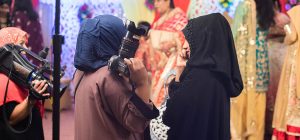
The Hyderabadi Muslim wedding holds a unique place in the hearts of women since Zenana and Mardana are still prevalent. That implies that places are different for men and women. So, the Zenana is solely for females. Women are allowed to be themselves while dressing up for other women, being seen and captured on camera by other women as, sometimes even the photographers and videographers are female. She says that she was amazed to see ladies carrying equipment and donning burqas in the Zenana sections of these Hyderabadi weddings.
As a Muslim woman from Hyderabad, Nishat has been both a participant in and a recorder of this basically unnoticed facet of Hyderabadi society, including its traditions, manners, and styles.
Bharat Choudhary – The Silence of ‘others’:
Bharat Choudhary works as a photographer in London, England. He grew up in Nigeria before moving to India to pursue his education at Indian Institute of Forestry Management. He worked with CARE International in India for five years before moving to photography. He further studied MA in Journalism at the University of Missouri. Since 2011, he is consciously documenting issues of Islamophobia and racialization against Muslims in America, England, and France. Throughout his career as a photographer, Bharat has been recipient of the Ford Foundation International Fellowship, Alexia Foundation Professional Grant & Getty Images Grant for Editorial Photography. Besides his works are published in TIME, NY Times, Le Monde, International Herald Tribune & The Sunday Times Magazine, including many others.
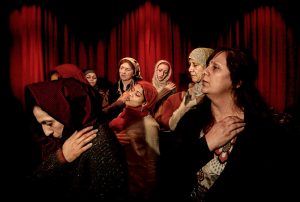
‘The silence of others’ by Bharat Chaudhary is an in-depth investigation of the perpetual islamophobia caused by war conflicts and thus resulting in debasement of Muslim communities. The War on Terror has developed anti-Islamic prejudice in the United States, leading to the notion that all Muslims are either “fundamentalists” or “terrorists.” This has resulted in a racist society in which American Muslims are racialised based on markers such as name, dress, phenotype, and language, rendering them subject to hate crimes, unlawful monitoring, and othering. While Chaudhary’s survey captures Muslim identities and the community, his images of Muslim women engaged in private activities like prayers and chats with other ladies, etc. stand distinctive. He records the activities, feelings, domestic spaces, and social experiences of Muslim women in the United States and Europe. His work, on the other hand, focuses on a broader perspective of social antagonism against Muslim men and women, which frequently impairs their freedom to freely practise their religion.
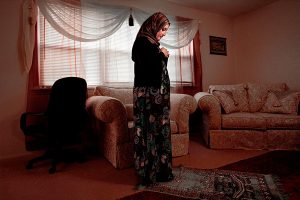
“USA. St. Joseph, Missouri. 2010. Deeba Safi prays at her house. Deeba and her husband, Ahmad, have been working with other Muslim families to establish the first Mosque in St. Joseph but have faced a lot of resistance from the local non-Muslims. [Update: The Mosque has been established and is now fully functional],”
He began working on the project throughout the Midwest, documenting stories in tiny communities around Missouri and Illinois, as well as major cities such as Chicago. Choudhary’s photography delves into the issues of isolation and ostracism experienced by his “Others” on both sides of the Atlantic, and the difficulty of breaking through their silence motivates him to continue the endeavour. His work includes narratives from a Missouri couple’s efforts to build the state’s first Mosque to a Caucasian woman’s conversion to Islam and the growth of Muslim communities in Chicago, London, and abroad.
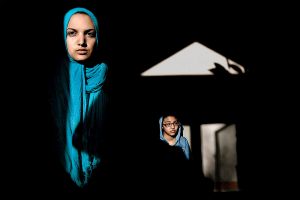
“USA. Bridgeview, Illinois. 2010. Amina Demir [left] and her younger sister were in their car when a middle- aged Caucasian male in a car next to them shouted, ‘sand nigger’ and drove away. Amina followed his car, noted the license plate number, and reported him to the police. A local court later sentenced the man to 150
hours of community service,”
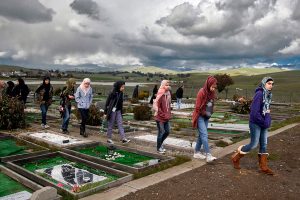
“USA. Livermore, California. 2018. A group of female students walk around the Five Pillars Farm Islamic graveyard during a lecture titled, ‘Visit to the Graveyard & Gravesite Reminders’. The lecture was taught by a renowned Islamic scholar, Imam Tahir Anwar (not in the picture), who spoke about the do’s and don’ts in an Islamic graveyard, and how a dead body and its final resting place should be treated with utmost respect,”
Choudhary is continuing the project’s second phase in England, widening the body of work’s geographic reach, and growing it as a platform to assist Muslims and non-Muslims understand each other.
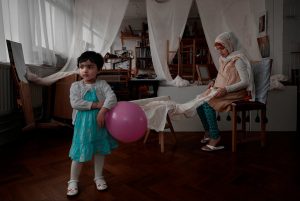
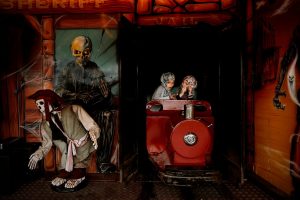
He acknowledged that the key dilemma for many young American Muslims, both men and women, was how to be both Muslim and American. He saw Europe becoming more hostile to Muslims, from Swiss ban on the construction of minarets to the prohibition of the Niqab, a headgear that covers a Muslim woman’s face. Through his photographs he aimed to chronicle the changes with his camera. “I can’t keep quiet,” he says.
References:
- Shweta Mehta Sen, 19th December 2018, “Chronicler of Lives on Mumbai Locals : Captured by Anushree Fadnavis”, Mansworld India, https://www.mansworldindia.com/culture/features/chronicler-lives-mumbai-locals-captured- anushree-fadnavis/
- Nishat Fatema, “What is it like being a female fashion photographer in India,” Elle,https://elle.in/article/female-fashion-photographer-india/
- Barny Rodgers,7th March 2019, “These 8 women photographers spotlight equality in India”, Grazia, https://www.grazia.co.in/people/this-international-womens-day-we-train-our-focus- on-fem
- https://www.bharatchoudhary.com/
- Bharat Chaudhary, “The silence of others”, Philip Jones Griffiths Foundation, https://philipjonesgriffiths.org/previous-winners/bharat-choudhary-the-silence-of- others/
- Jared T. Miller, 1st December 2011, “The silence of others: Exploring Islamophobia through images”, Time, https://time.com/19234/the-silence-of-others-exploring- islamophobia-through-images/
- Bharat Chaudhary, “The silence of ‘others’,” Feature, Lens Culture, The Silence of “Others”
– Photographs and text by Bharat Choudhary | LensCulture
- James Estrin, 26th January 2012,“Challenging the silence of others,” Lens, Photography- Video-and Visual Journalism, The New York Times, https://archive.nytimes.com/lens.blogs.nytimes.com/2012/01/26/challenging-the-silence-of- others/

